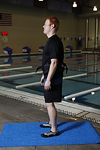Training for good posture may not sound as exciting as high intensity interval training or deep water running, but it is important for your future health and well being. Look at the two photos below. Which of these postures do you want to have as you get older?
The fact is that you may be training for the posture of the second man. If you spend a lot of time seated in front of a computer or using a mobile device, or if you spend a lot
 of time behind the steering wheel of your car, chances are that you are in a position known as passive forward flexion. In this posture, you are stretching out the muscles of your upper back, your erector spinae and your gluteus maximus. Once the muscles get stretched out, just like an elastic band that gets stretched out, it is hard to “tighten them up” again. Combine weak muscles on the back side of the body with the effects of gravity as we age, and the end result is that you become bent over, unable to stand up straight, and prone to poor balance and falls.
of time behind the steering wheel of your car, chances are that you are in a position known as passive forward flexion. In this posture, you are stretching out the muscles of your upper back, your erector spinae and your gluteus maximus. Once the muscles get stretched out, just like an elastic band that gets stretched out, it is hard to “tighten them up” again. Combine weak muscles on the back side of the body with the effects of gravity as we age, and the end result is that you become bent over, unable to stand up straight, and prone to poor balance and falls.

What to do? One thing you can do is take frequent breaks away from your computer, mobile device, etc. Standing up or walking around takes some of the stress off of those stretched out muscles. The other thing you can do is train your body for good posture in your water fitness class.
- Lift your sternum. This one simple action brings the head into alignment with the spine and pulls the shoulders back.
- Keep your spine in neutral. This means that the cervical, thoracic and lumbar regions of the spine are aligned in their natural curves.
- Brace your core before beginning any exercise. Once you are in neutral spine, tighten the muscles of the back and abdomen to maintain that neutral alignment.
- Strengthen the postural muscles – the middle trapezius, latissimus dorsi, erector spinae, gluteus maximus, and the abductors and adductors in the hips.
- If you are in deep water, resist the temptation to lean forward at the waist to make the exercises easier to do or to travel faster through the water. This position inhibits the proper muscles from doing the work, and it creates spinal compress
 ion equal to running on pavement. Instead concentrate on increasing your frontal resistance and dragging the water along with you. You will move slower, but you will work harder and your posture will improve.
ion equal to running on pavement. Instead concentrate on increasing your frontal resistance and dragging the water along with you. You will move slower, but you will work harder and your posture will improve.
